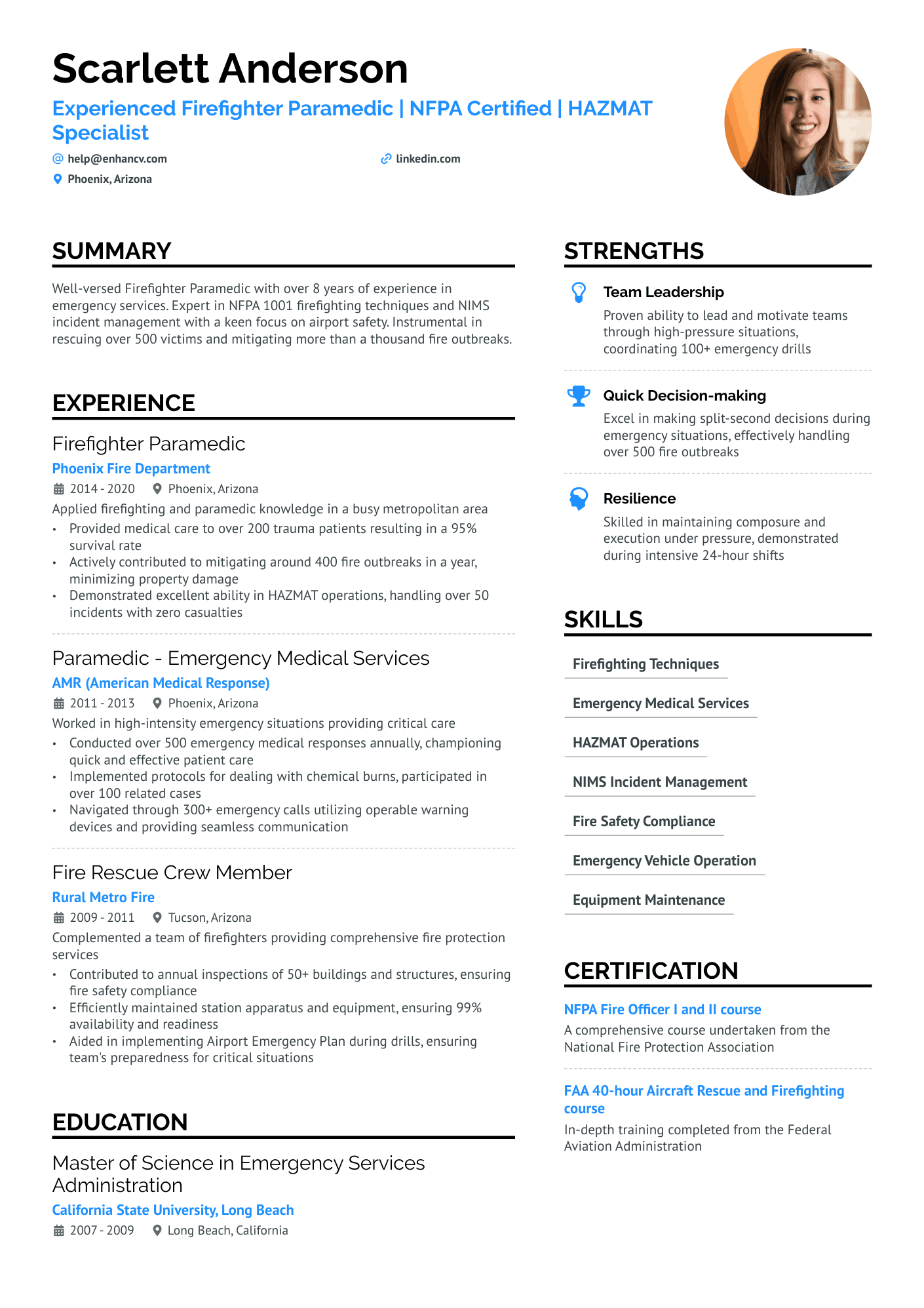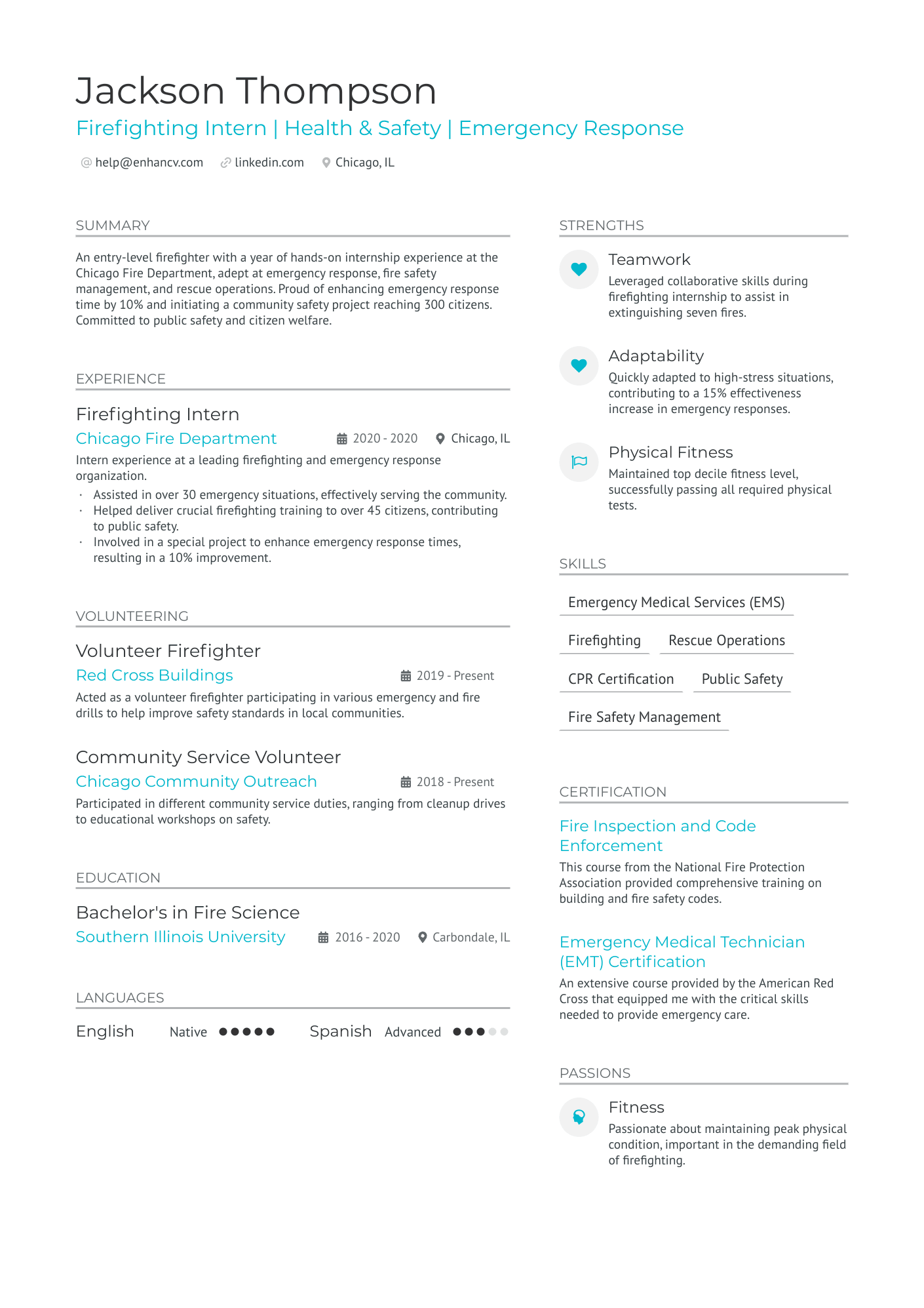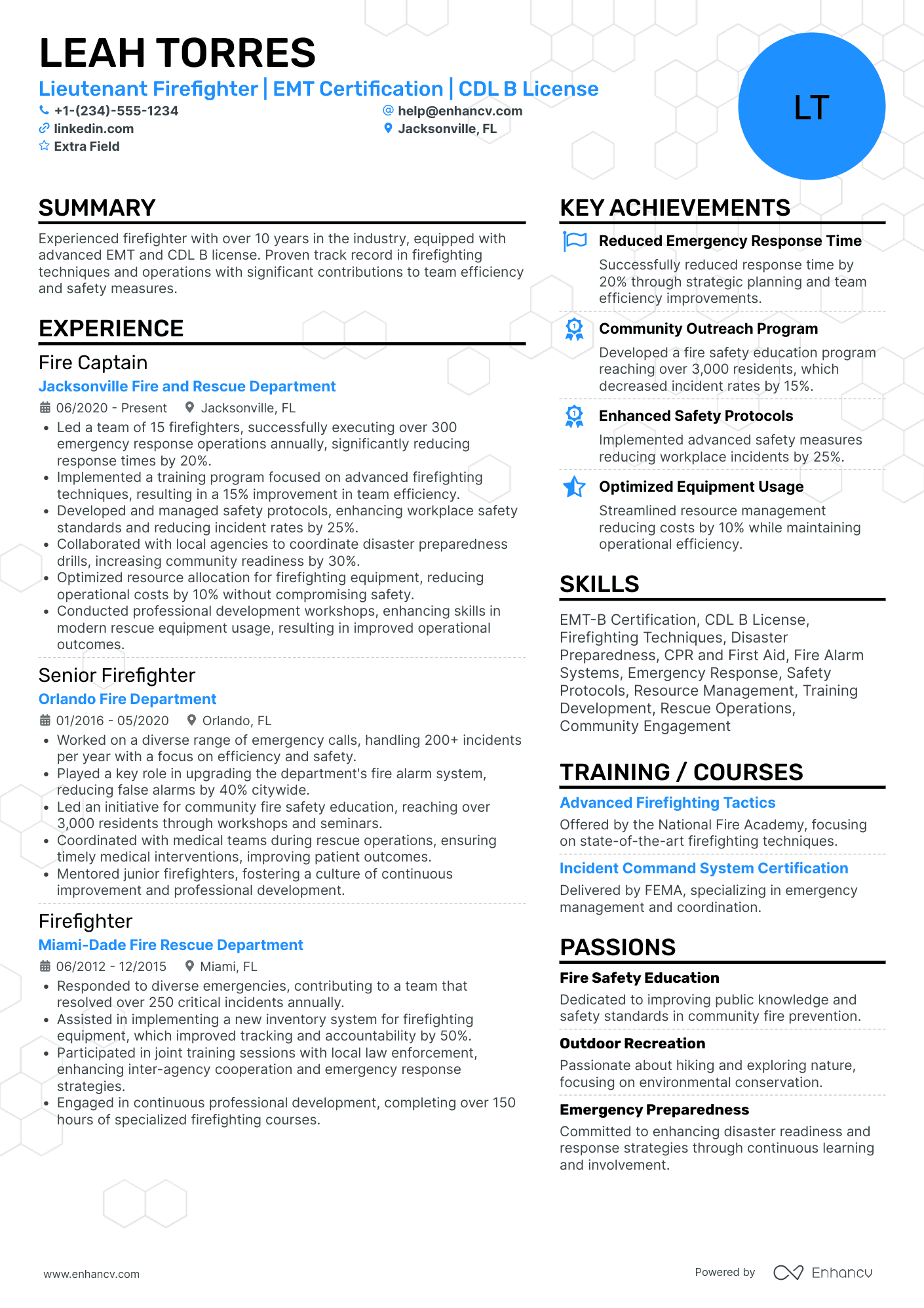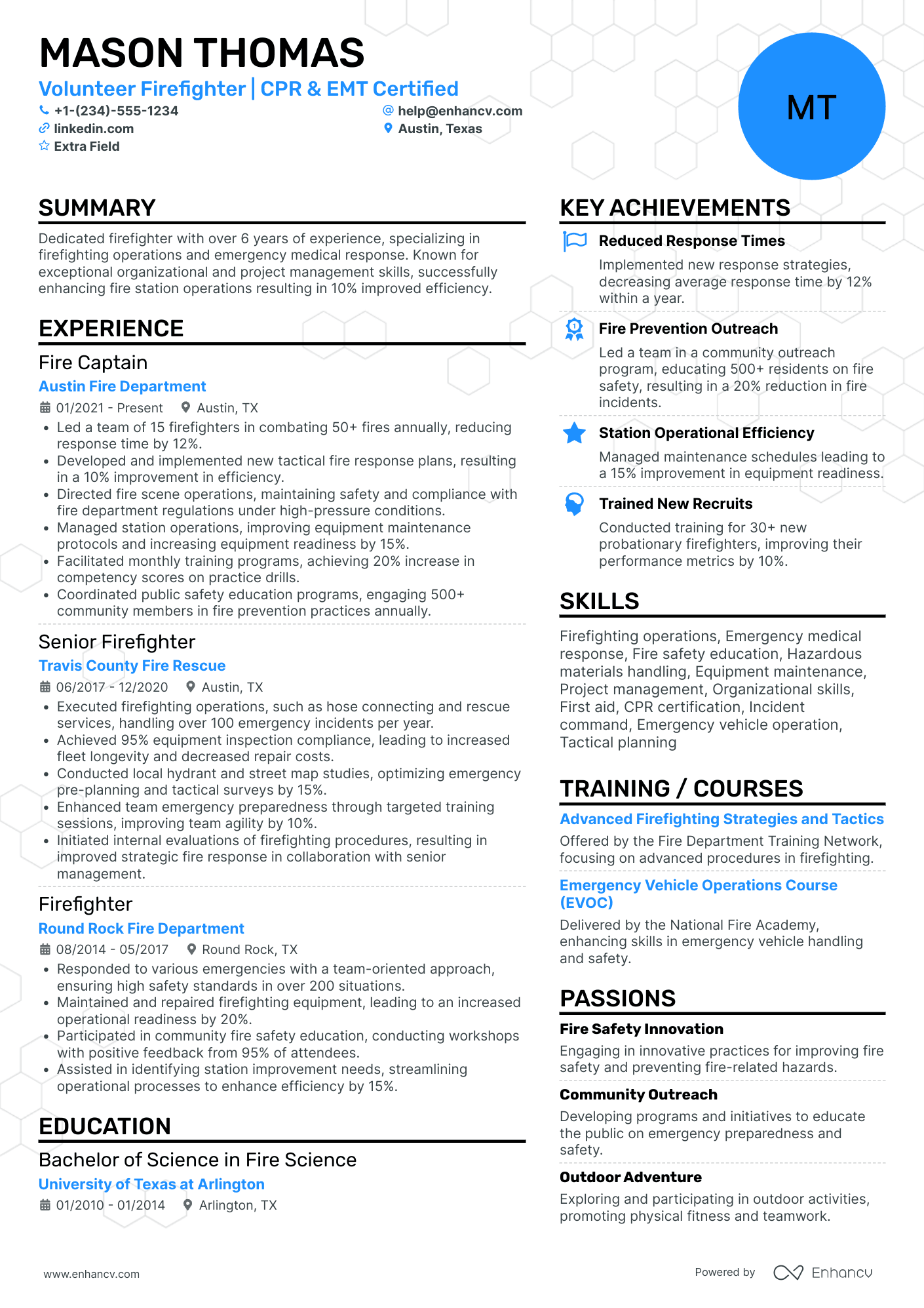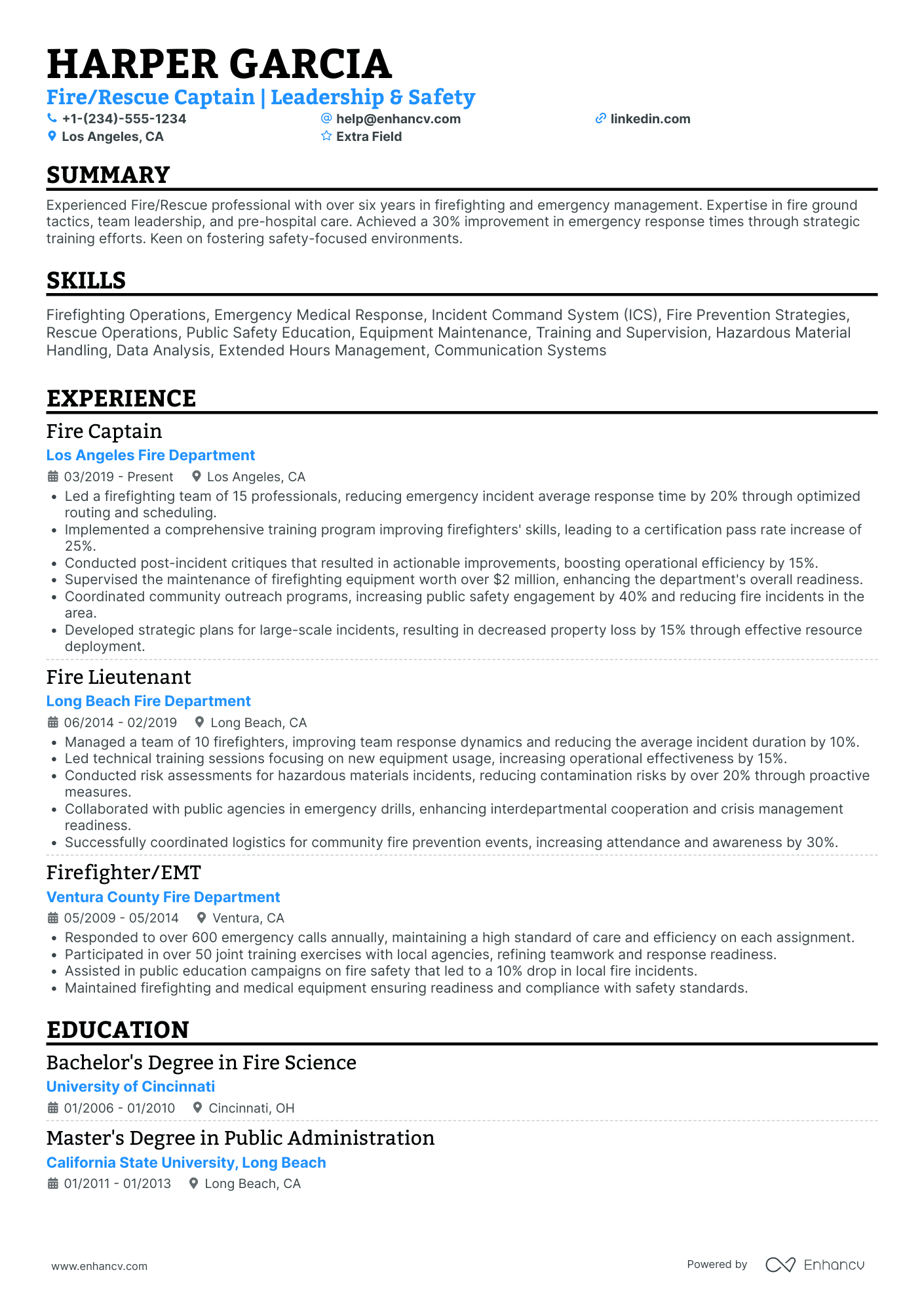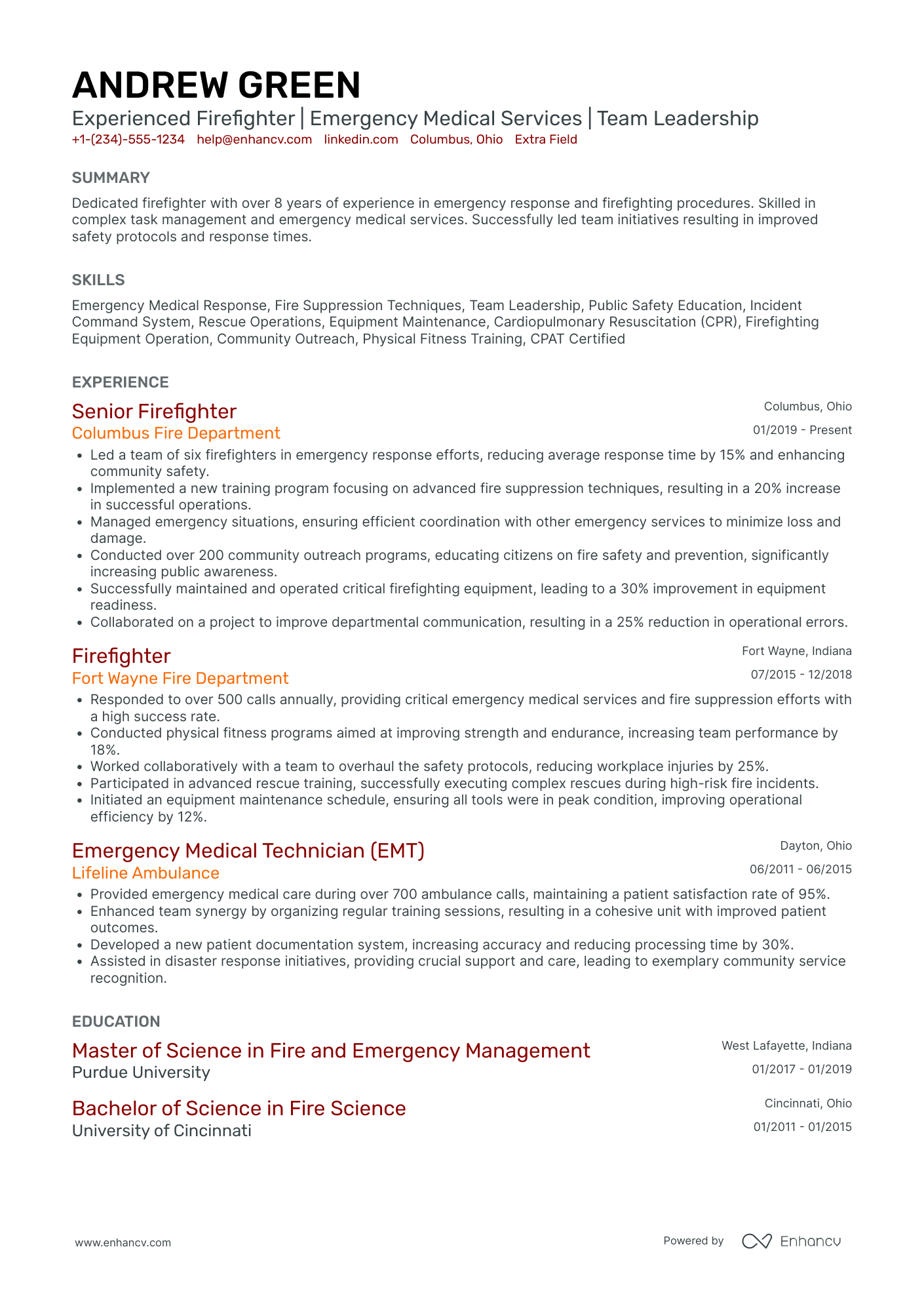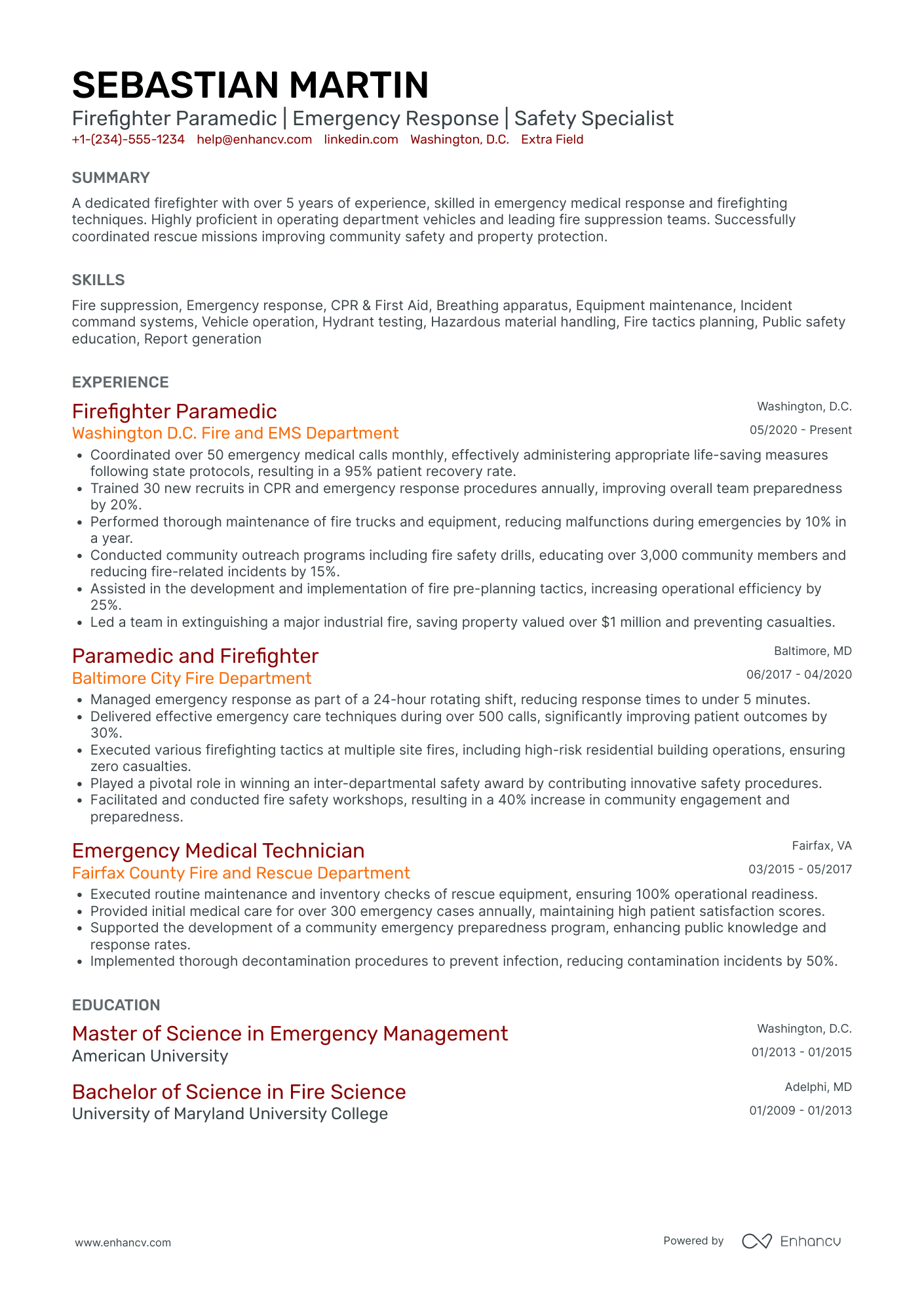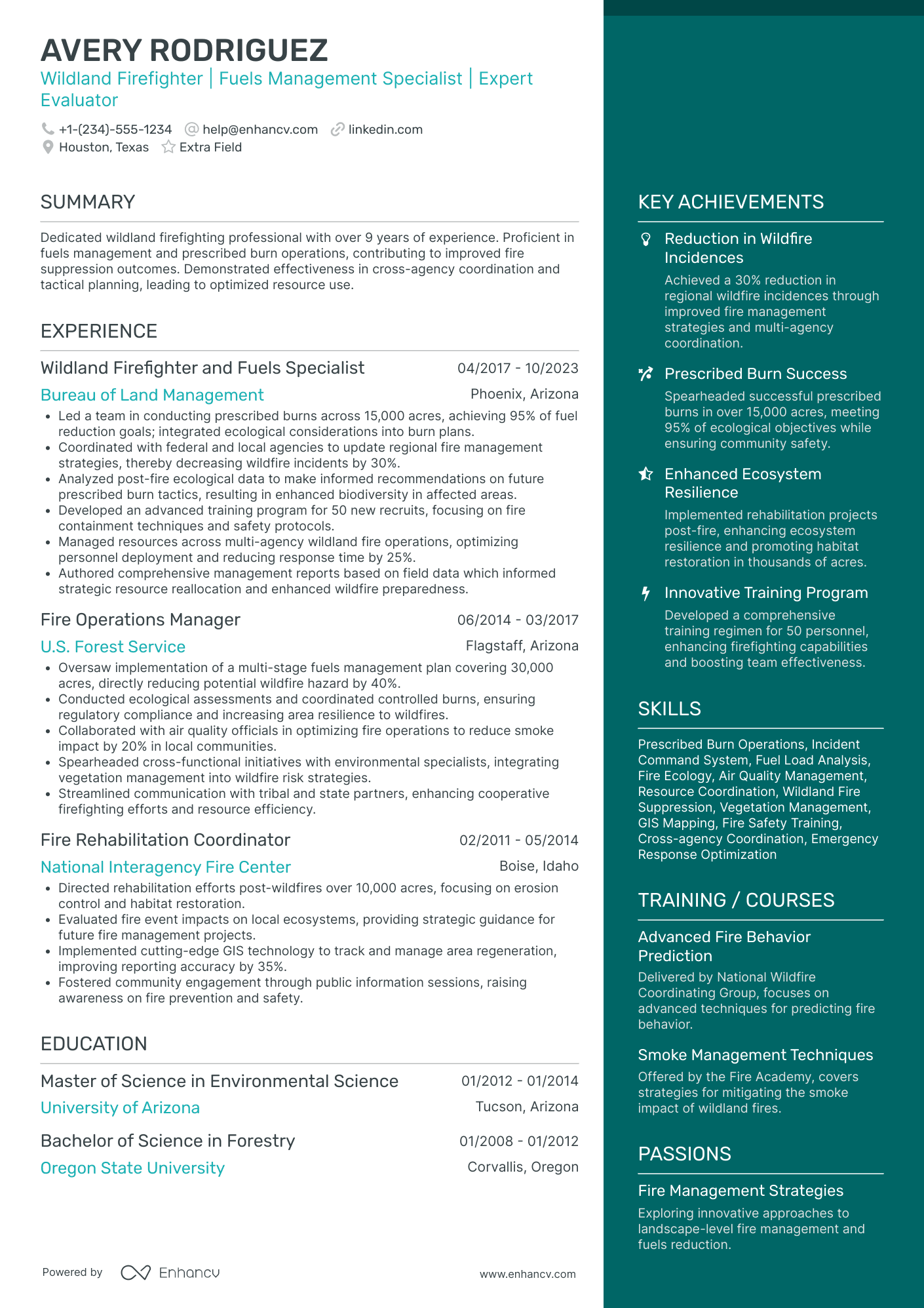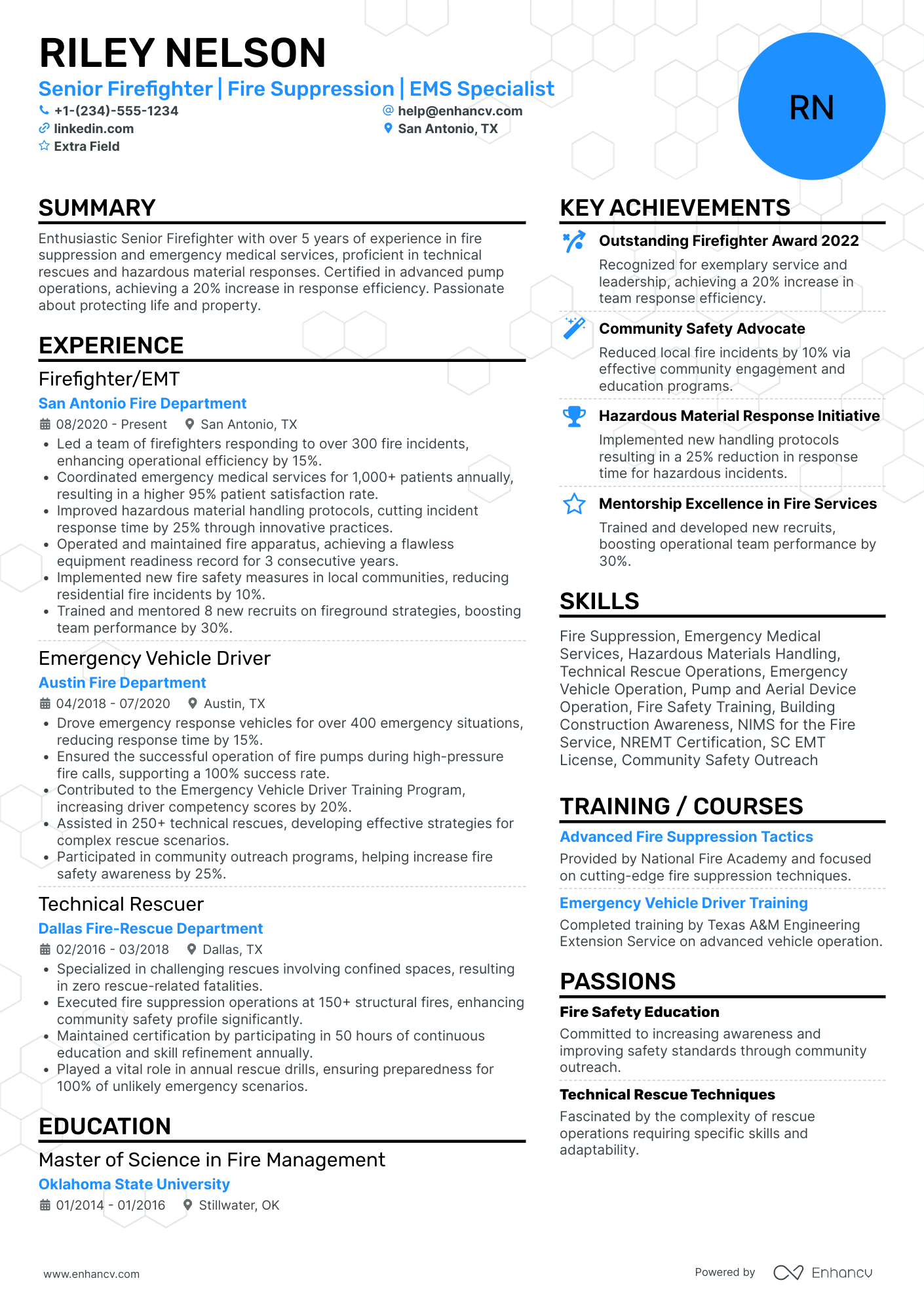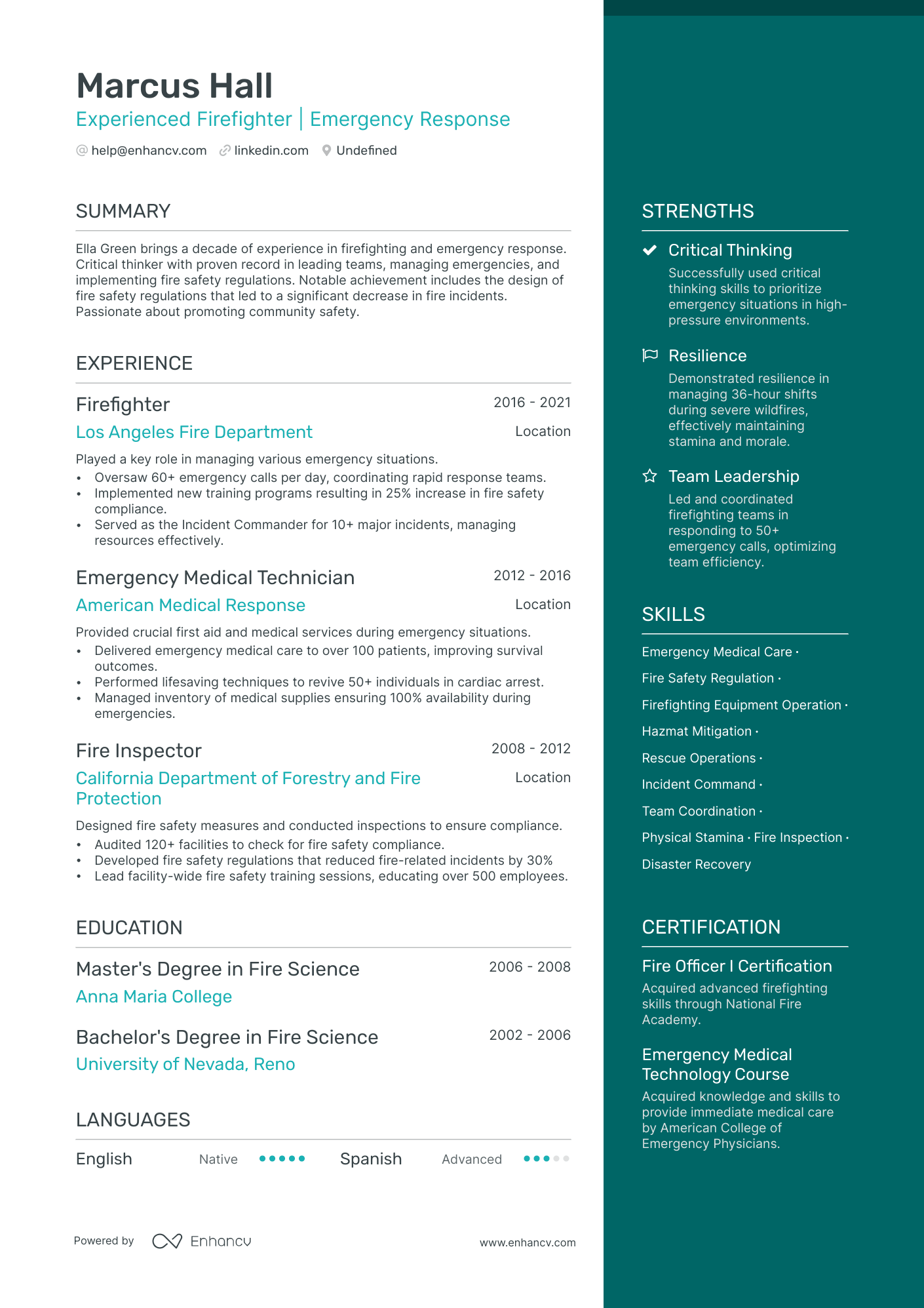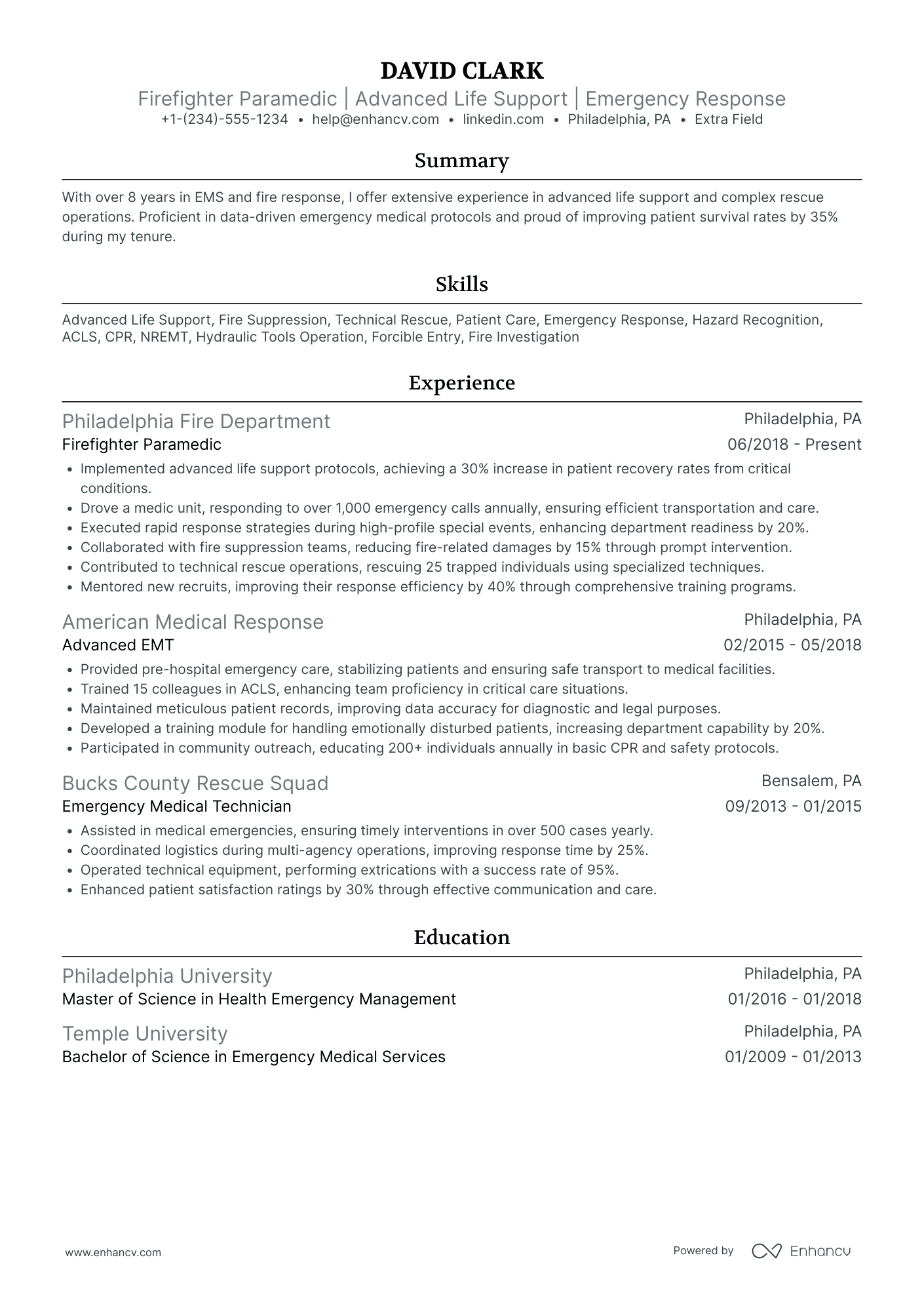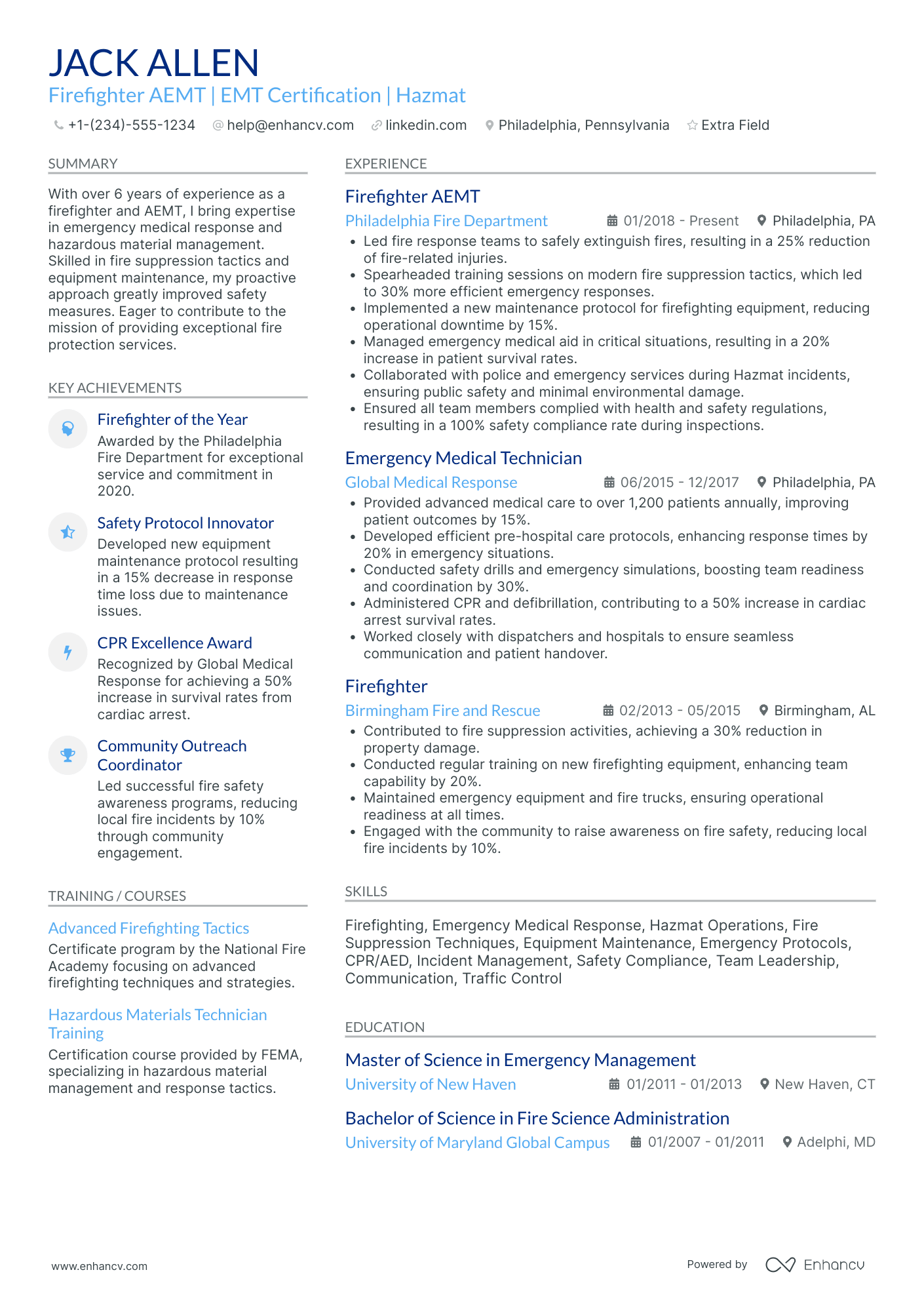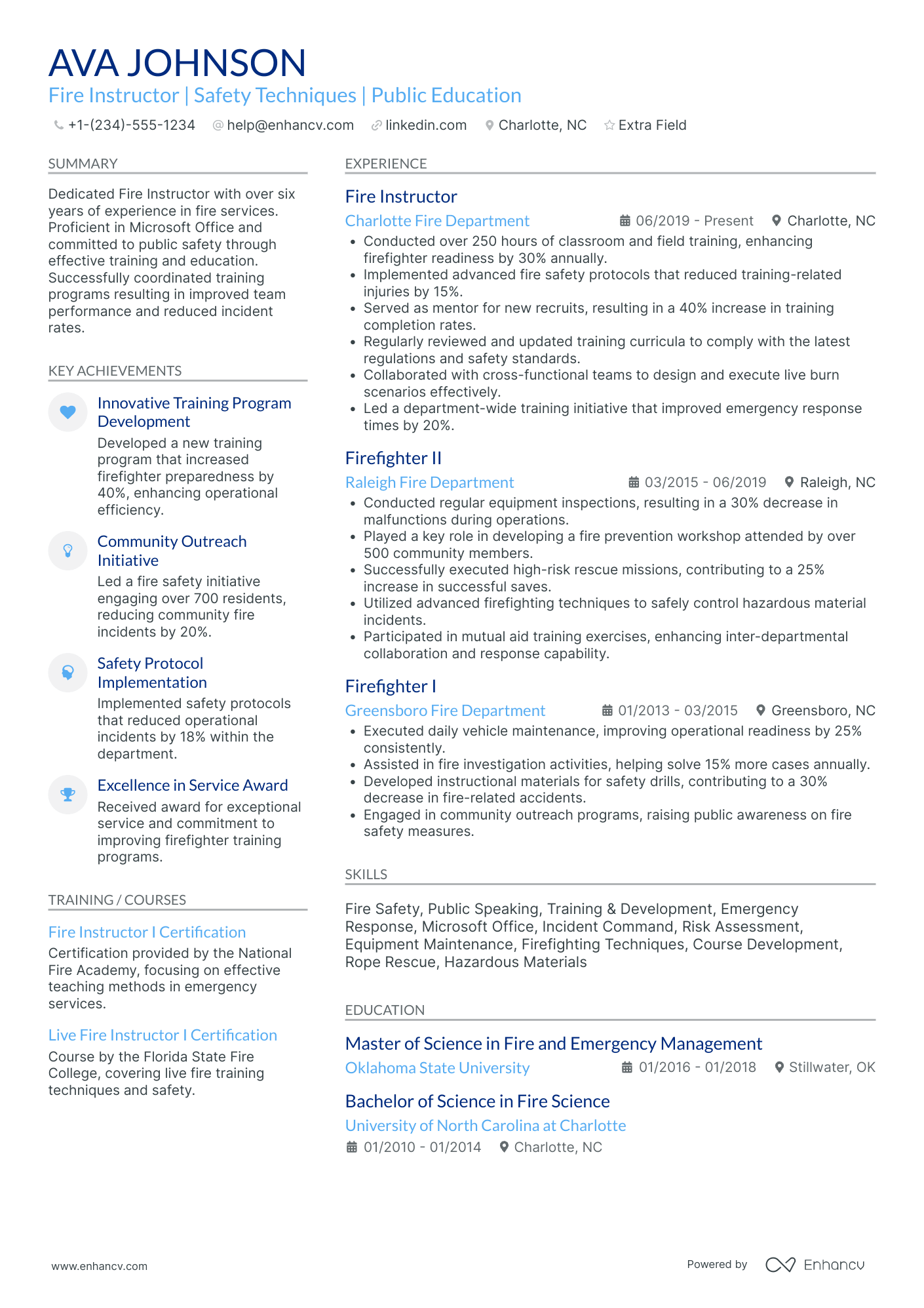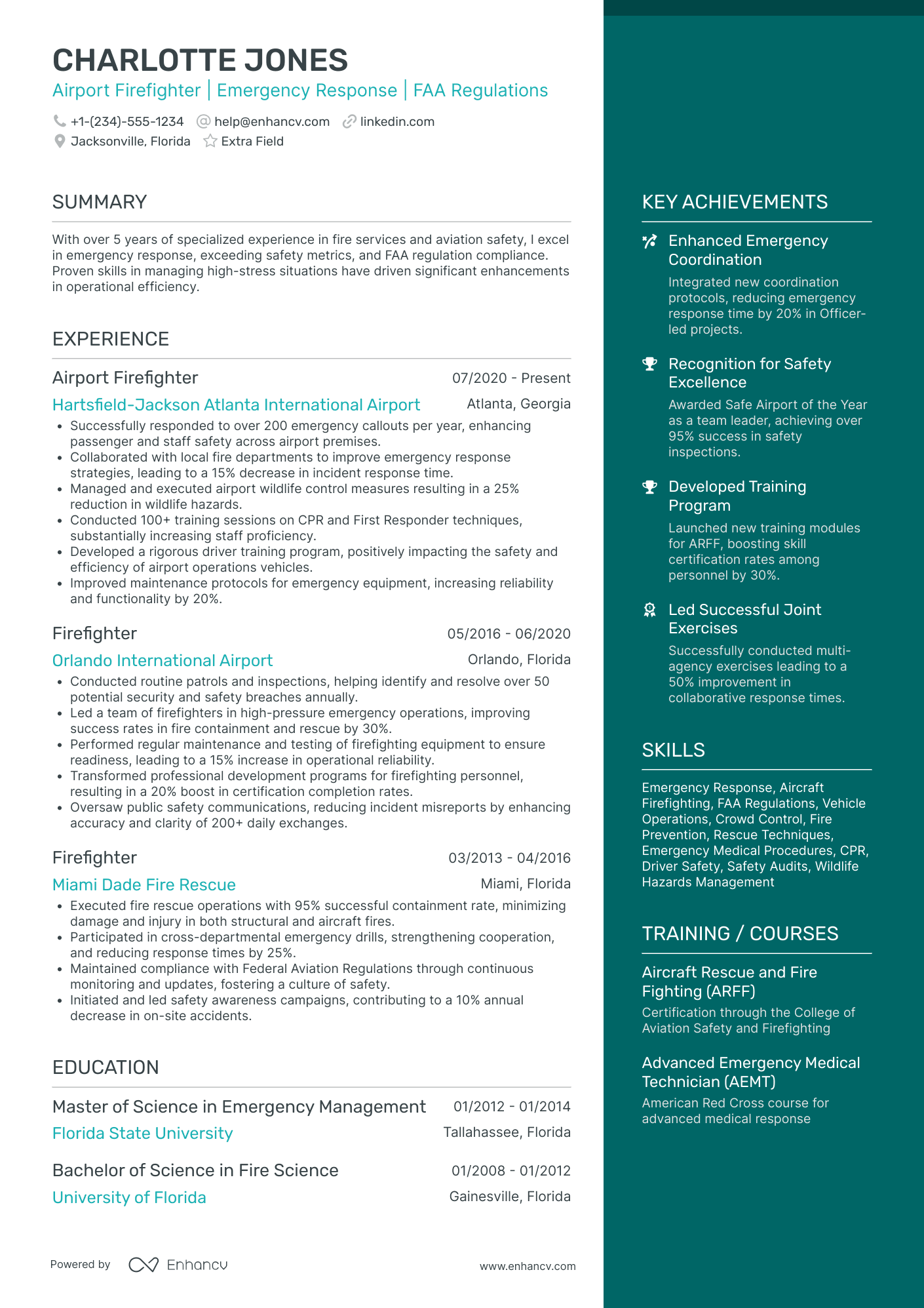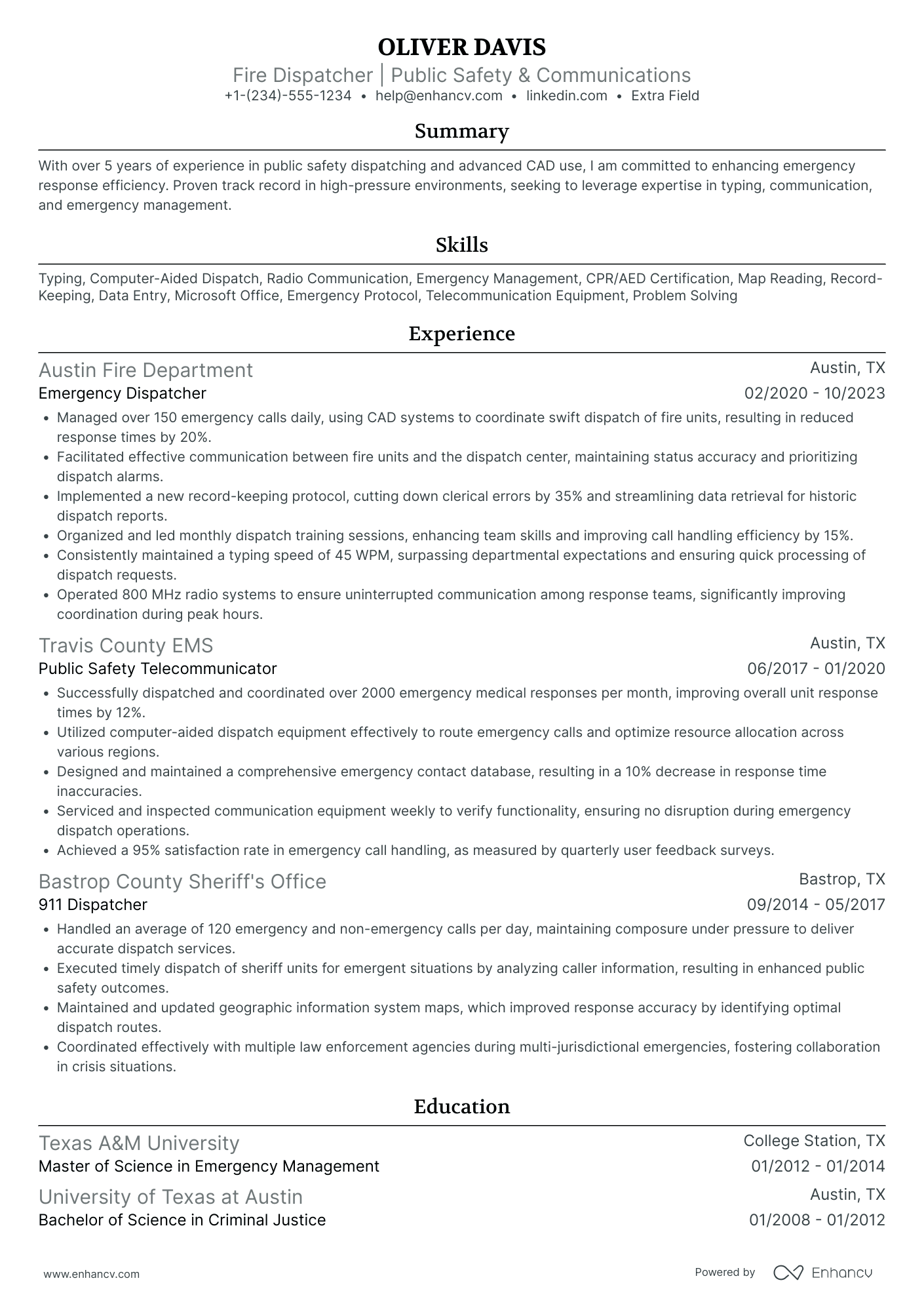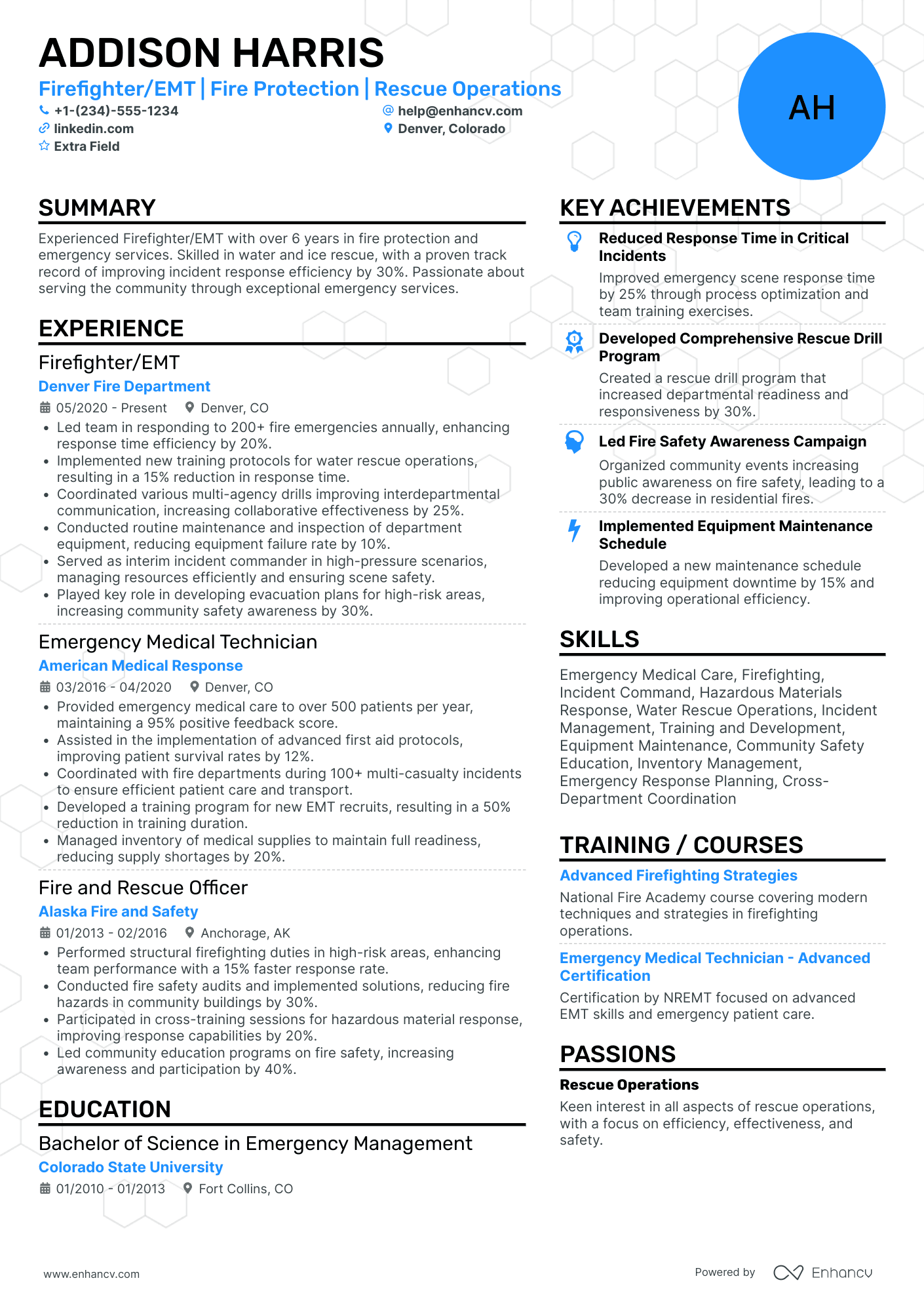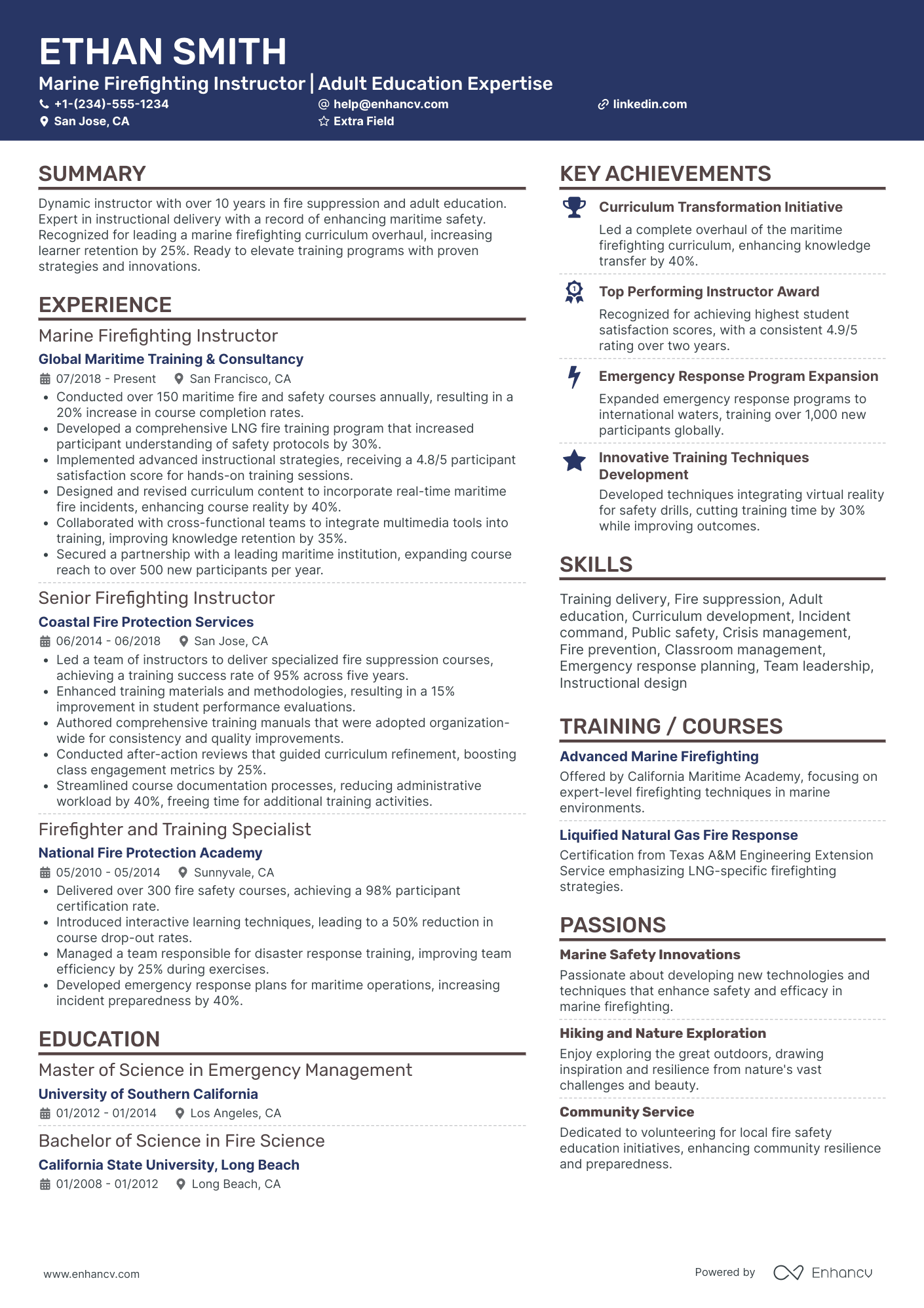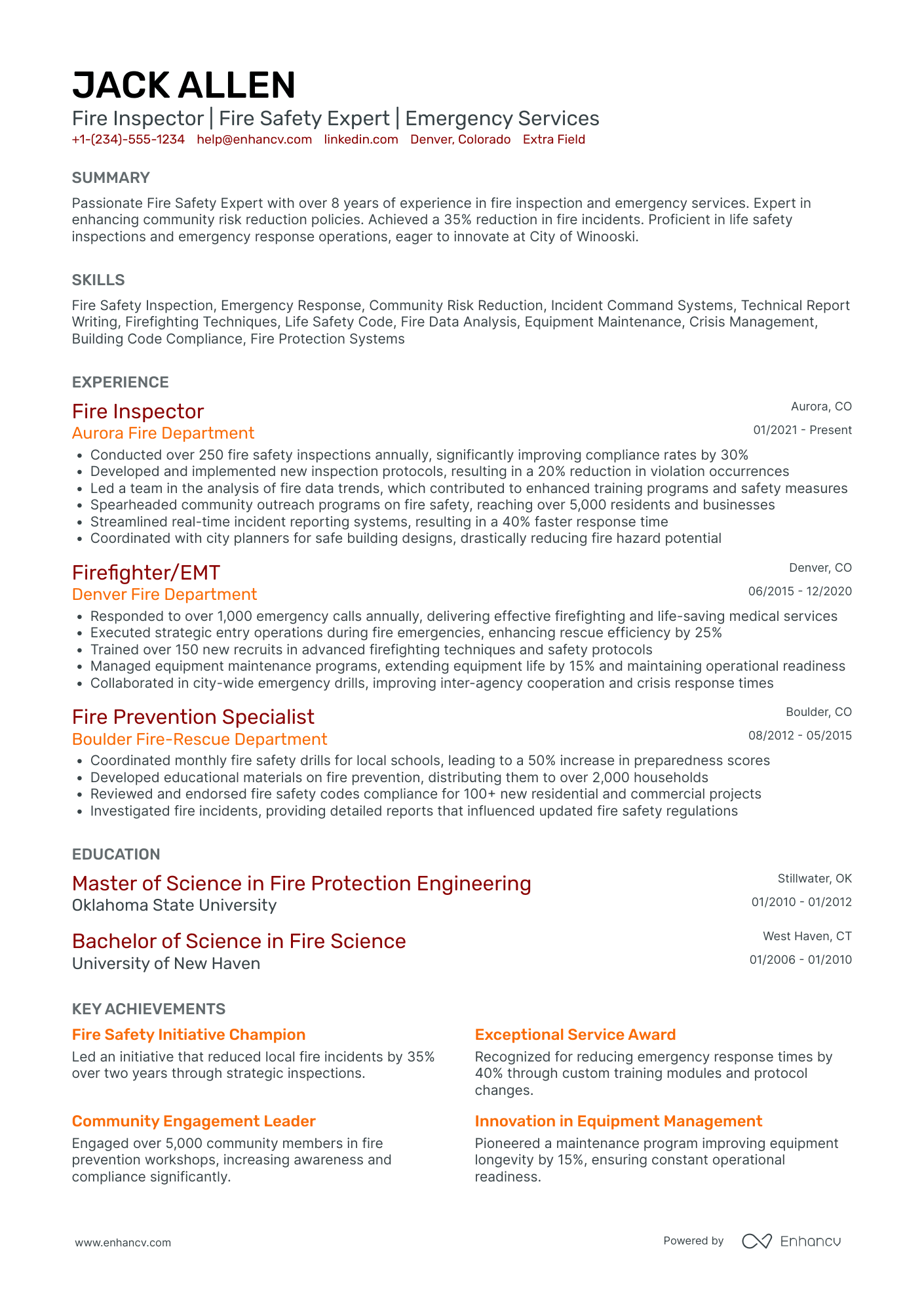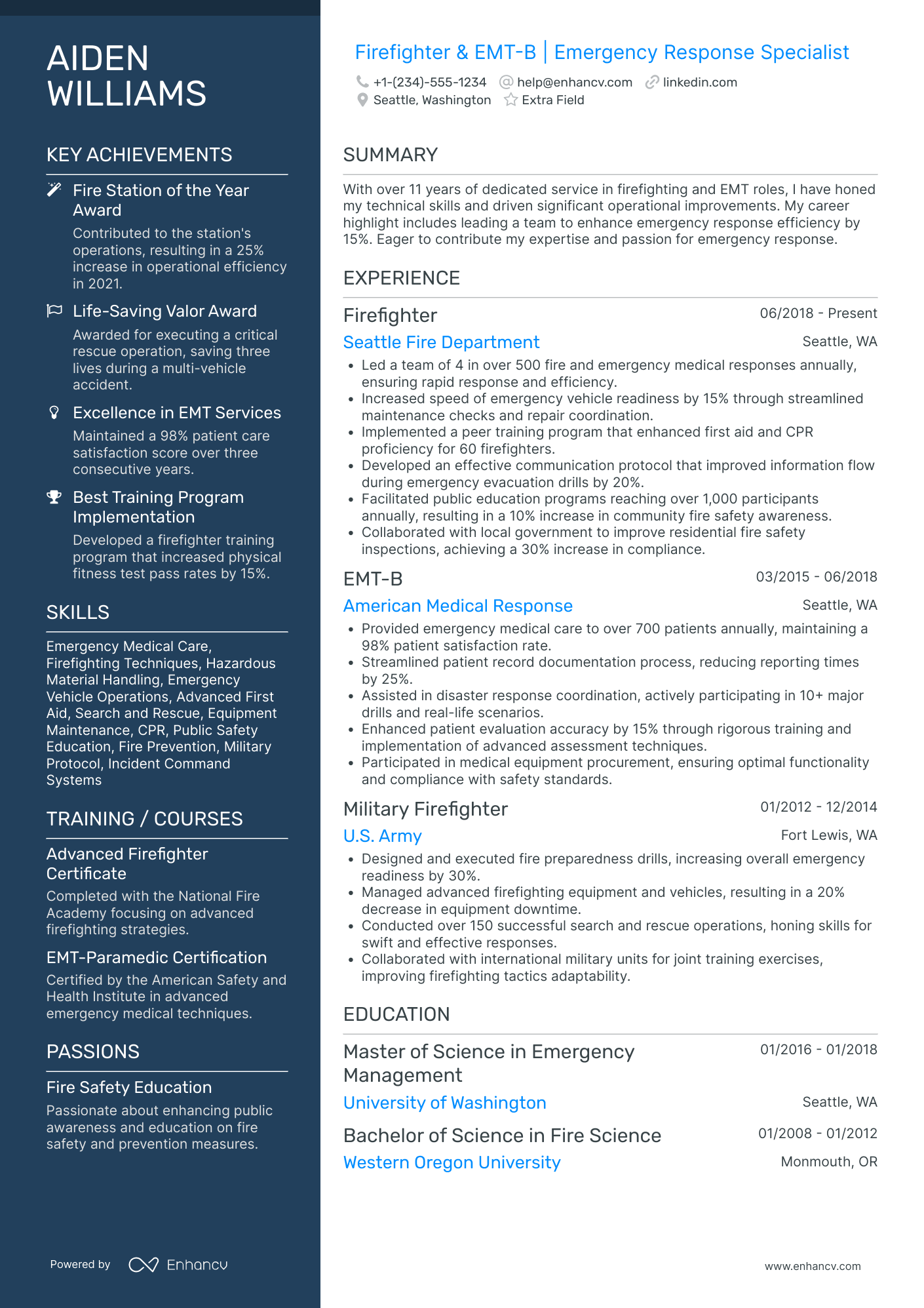With wildfires becoming more frequent and intense, it's clear the challenges in firefighting are evolving. Climate change is pushing us to adapt and rethink how we manage these disasters. The need for skilled firefighters who are ready to face these challenges head-on has never been more critical.
If you're considering a career in firefighting, you're looking at an opportunity to make a real difference. The job now involves not just battling blazes but understanding and responding to the broader impact of climate change on our environment. It’s about being part of a new generation of firefighters who are as committed to sustainability as they are to saving lives and property.
But here’s the question: how do you capture your readiness and your diverse skills in a resume? How do you make sure your application stands out in a field where the demands are as dynamic as the fires you’ll be fighting?
Our guide is designed to tackle this challenge. After reading the article below, you'll build a resume that not only shines a light on your unique blend of courage and commitment but also opens doors to new opportunities. Here’s what we’ll cover:
- How to build a readable and concise resume that passes ATS and recruiters’ assessment.
- How to translate your front-line experience into a compelling narrative that highlights transferable skills such as leadership, crisis management, and teamwork.
- How to quantify your achievements and impact, turning your everyday heroics into measurable milestones that catch a recruiter's eye.
- How to play around with resume sections and organize them in the best way possible, demonstrating your suitability for the role you’re applying for.
Whether you're aiming to advance within the fire service or pivot to a new career path, building a resume that fully captures your experience, skills, and bravery is no small feat. Let’s get started.
Are you considering any other public safety role? Check out some other related resume examples.
- Volunteer firefighter Resume
- Police Officer Resume
- Entry-level Police Officer Resume
- Public Safety Officer Resume
- Law Enforcement Resume
- Firefighter Cover Letter
How to format a firefighter resume
Usually, we talk about three main types of resume layouts. The reverse chronological resume lists employment history starting with the most recent positions first and is best suited for individuals with extensive experience. The second one is the functional resume, which emphasizes skills over chronological work history. It’s ideal for entry-level candidates or those with career gaps.
In the case of firefighters, however, the most reasonable choice is the combination, or hybrid, resume. This format allows for a dedicated section to highlight your transferable skills upfront, such as crisis management, teamwork, leadership, problem-solving, and effective communication. The hybrid resume is also particularly beneficial for firefighters looking to advance within the fire service or transition into new roles where emphasizing the applicability of their skill set is crucial.
Formatting tips for a job-winning resume
A resume demands paying attention to some very specific details like ATS-friendly fonts and acceptable file formats. Below, we break down the formatting principles you should follow when building your firefighter resume.
Think about the market’s preferences – a Canadian resume, for instance, could have a different layout.
- Resume header: Include your name, contact information, and location. This is also the ideal place to put a link to your LinkedIn account.
- Fonts: Go with a professional, readable font that can be easily recognized by applicant tracking systems. Lato, Arial, Rubik, or Calibri, size 10-12 pt would work perfectly for a firefighter resume.
- Margins: This part of your resume should comply with industry standards and shouldn’t be less than 1 inch wide. Margins provide white space on a resume and make it easy to read.
- Layout: Go for a clean layout (a single- or double-column resume) and keep your resume length no more than 1 page long.
- Language: Proofread your resume for typos and grammar mistakes. If you’re not confident, use our resume checker—it’ll do the necessary optimization for you.
- PDF format: Many people have expressed frustration with their resumes failing to pass the ATS assessment. In many of those cases, the file format is the reason. So, make sure you save your resume as a PDF file to preserve the layout across all devices and platforms.
If you already have a resume built, chances are it might not be ATS-friendly. Click the button below to see if it passes the test or not.
Is your resume good enough?
Drop your resume here or choose a file. PDF & DOCX only. Max 2MB file size.
Now that we covered the foundations of a well-organized resume, have a look at the must-have sections you’ll need to fill in.
The top sections on a firefighter's resume
- Firefighting and rescue experience: Demonstrates hands-on experience and success in firefighting, rescue operations, and emergency response.
- Emergency medical services (EMS) skills: Highlights qualifications in providing medical assistance, showcasing the ability to perform under pressure.
- Fire safety and prevention education: Reflects contributions to community safety through educational programs, inspections, and compliance efforts.
- Specialized training: Experience in managing hazardous situations is critical for safety roles.
- Professional certifications: Lists relevant certifications such as EMT, firefighter I/II, and HazMat, underscoring specialized skills and knowledge.
Now consider how recruiters interpret these sections and what they’ll be on the lookout for when reviewing your application.
What recruiters want to see on your resume
- Proven experience in firefighting and emergency response: Recruiters look for hands-on experience to ensure candidates can handle the physical and mental demands of the job.
- Certifications such as EMT, firefighter I/II, and HazMat: These are essential qualifications that demonstrate the candidate's commitment and readiness for the role.
- Physical fitness and agility: Necessary to perform the strenuous duties of firefighting, including carrying heavy equipment and rescuing individuals.
- Teamwork and communication skills: Critical for effectively working in teams during high-pressure situations and ensuring safety and coordination.
- Community service and public education: Showcases the candidate's dedication to fire prevention and safety awareness within the community.
To demonstrate your effectiveness as a fireman, learn how to describe your work experience. We’ll dive into more detail on that in our next section.
How to write your firefighter resume experience
The largest part of your resume should showcase your practical application of skills and knowledge in real-world situations. This is the place to prove you can handle the intense and varied demands of firefighting and emergency response.
The most common approach for writing your experience section is to use the reverse chronological order.
- Begin with the title of the most recent position held.
- Mention the dates of employment and the name of the organization.
- List key responsibilities, achievements, and any specialized tasks or operations.
Remember, highlighting quantifiable achievements, like the number of fire incidents managed or training sessions led, can significantly boost your profile by demonstrating the tangible impact of your work.
Let’s see this in practice, starting with an exaggeratedly bad example.
- •Responded to numerous emergency calls each year, dealing with a range of situations.
- •Participated in discussions with the LA County Emergency Services to put together a wildfire prevention plan.
- •Attempted to improve team efficiency through the creation and delivery of a training program, covering various firefighting techniques.
- •Carried out a number of fire safety inspections and held community education sessions.
These achievements don’t sound particularly impressive as they lack quantifiable outcomes. It’s a list of routine tasks, presented in a mundane light.
The improved version below shows how much more depth you can add to your experience section with a few tweaks.
- •Responded to over 300 emergency calls annually, including fires, medical emergencies, and hazardous material incidents, demonstrating rapid decision-making and a commitment to community safety
- •Collaborated with the LA County Emergency Services to develop and implement a comprehensive wildfire prevention program, contributing to a 20% reduction in wildfire occurrences in the Los Angeles area.
- •Enhanced team efficiency by 15% through the design and delivery of an in-house training program focusing on advanced firefighting techniques, emergency medical care, and team leadership.
- •Conducted 200+ fire safety inspections and community education sessions annually, raising local fire safety standards and promoting preventive practices among community members.
The effectiveness of these entries is evident through several key aspects:
- Quantified achievements: The entry quantifies the firefighter's contributions, such as responding to over 300 emergency calls annually and conducting more than 200 fire safety inspections each year. These metrics offer a clear, measurable impact of the firefighter's work.
- Action verbs: The use of strong action verbs like responded, collaborated, enhanced, and conducted at the beginning of each bullet point actively highlights the firefighter's role in each accomplishment. This makes the resume more dynamic and places the individual as a proactive and essential contributor to their team and community.
- Key skills: The section demonstrates a range of key skills vital for a firefighter, including rapid decision-making, teamwork and collaboration (especially with LA County Emergency Services), leadership (evidenced by enhancing team efficiency and leading training programs), and community engagement (through fire safety inspections and education sessions).
To emulate the best practices for writing a resume experience section, follow our tips below.
How to quantify impact on your resume
Quantifying achievements on a resume provides evidence of your capabilities and impact. Here are tailored instructions to make your firefighter resume more impactful:
- Include the total area (in square miles or acres) you helped protect from wildfires, demonstrating your contribution to safeguarding community and natural resources.
- Mention the percentage decrease in fire incidents or emergency calls in areas where you led public education initiatives, showing your effectiveness in preventive measures.
- List the exact number of fire safety inspections conducted, highlighting your thoroughness and commitment to safety standards.
- Detail the number of training sessions you've conducted or participated in, underscoring your dedication to continuous improvement and skill enhancement.
- Specify the volume of emergency medical services calls you've responded to, reflecting your versatility and efficiency in critical situations.
- Report the amount of equipment and assets you've managed or maintained, indicating your responsibility and the trust placed in you to handle valuable resources.
- Present the number of community outreach programs you've initiated or been involved with, showcasing your commitment to community engagement and safety education.
- State the number of high-risk interventions you've participated in, such as complex rescues or hazardous materials incidents, demonstrating your capability in high-stakes environments.
Regardless of your experience level, try to add quantifiable achievements to each statement you make on your resume. This speaks volumes about your commitment to the profession.
Real heroes are men who fall and fail and are flawed, but win out in the end because they've stayed true to their ideals and beliefs and commitments.
Kevin Costner
Next, we’ll discuss how to write a resume if you’re a first-time firefighter.
How do I write a firefighter resume with no work experience
For firefighters starting their careers with no direct experience, crafting a compelling resume can still be achieved by emphasizing relevant skills, volunteer experiences, certifications, and education. Here are key strategies to consider:
- Highlight education and certifications: To show your readiness to begin work, start with your firefighting education, any relevant certifications, or emergency medical training, such as hazardous materials handling.
- Emphasize transferable skills: Even if you haven't worked as a firefighter, you likely have skills from other experiences that are valuable in firefighting. Highlight teamwork, physical fitness, decision-making under pressure, and any leadership experience. Use examples from school, sports teams, or other jobs to illustrate these skills.
- Volunteer experiences: If you've volunteered, especially in roles related to emergency services, community safety, or first aid, detail these experiences. Volunteering shows a commitment to community service and can provide practical skills relevant to firefighting.
- Soft skills: Firefighting requires a strong set of soft skills, including communication, empathy, and resilience. Provide examples of how you've demonstrated these in other settings.
- Technical proficiencies: List any technical skills and proficiencies, especially those related to emergency response, such as familiarity with firefighting equipment, emergency dispatch software, or first aid techniques.
- An objective statement: This demonstrates your enthusiasm and commitment to pursuing a career in firefighting, while also highlighting your understanding of the role's demands.
Above all, customize your resume for the job: Tailor your resume to align with the specific requirements and duties of the firefighter position you're applying for. Use keywords from the job listing to make your resume more relevant.
PRO TIP
Test your draft firefighter resume by sending it out to peers and mentors in your circles. Ask them to review it as if they were hiring you for a project and implement the feedback afterward.
We’ll explore each of the bullet points above further in the guide. Next—skills on a resume.
How to list hard and soft skills on your resume
We've already highlighted the importance of using keywords in your resume. They provide clear guidance for the entire resume-writing process. It's simple—review the job description, take note of the requirements, and then make sure you incorporate these exact words into your resume. Why? It's the most effective way to pass ATS scanners and grab recruiters' attention.
When deciding which skills to include in your resume (and we imagine there are many), prioritize those mentioned in the job posting and relevant to the position you're applying for. (Being a proficient user of programming languages might be impressive, but it won't save lives if you're applying for a firefighter position).
Moving on to practical skills. Your hard skills are acquired through education, certifications, and training, so it's crucial to prominently display them in a dedicated section of your resume.
Best hard skills for your firefighter resume
- Emergency Medical Services (EMS) certification
- Fire suppression techniques
- Hazardous materials handling (HAZMAT)
- Fire safety inspection protocols
- CPR and First Aid certification
- Firefighting equipment operation (hoses, extinguishers, ladders)
- Incident command system (ICS) knowledge
- Wildland firefighting techniques
- Structural firefighting strategies
- Fire prevention and education methodologies
- Technical rescue techniques (confined space, high angle, trench)
- Water rescue certification
- Fire scene investigation and reconstruction
- Building codes and fire regulations comprehension
- Emergency vehicle operation
- Fire alarm and suppression systems maintenance
- Firefighting personal protective equipment (PPE) usage
- Basic life support (BLS) certification
- Thermal imaging technology usage
- Radio and communication systems proficiency
Interpersonal skills are equally important to include in your resume. However, to avoid simply listing them, think of how you could integrate them within other resume sections. This would save you space and will also allow you to prove them by providing context.
For example, these skills can be easily incorporated into the objective statement or in your experience section entries. For instance:
- Played a pivotal role in a high-profile rescue operation during the 2020 California wildfires, safely evacuating 50+ residents from a threatened neighborhood and receiving the Fire Chief’s Commendation for bravery.
This experience example illustrates how you can imply certain skills (bravery, working under pressure, problem-solving) without explicitly mentioning them. Only make sure you give enough context and quantify your achievements.
Below is a list of the most valued soft skills a firefighter should possess.
Best soft skills for your firefighter resume
- Leadership
- Teamwork
- Communication
- Decision-making
- Stress management
- Adaptability
- Problem-solving
- Empathy
- Integrity
- Physical fitness
- Critical thinking
- Resilience
- Initiative
- Attention to detail
- Conflict resolution
- Time management
- Patience
- Accountability
- Emotional intelligence
Next, we focus on the necessary education for a firefighter.
How to list education and certifications on your resume
The importance of education for firefighters in the U.S. can vary significantly depending on the fire department and the specific role within firefighting. For instance, in many regions, the field is highly competitive, so having a degree in fire science can make a candidate more attractive to hiring committees by demonstrating a commitment to the profession and a deeper understanding of fire behavior, emergency management, and fire prevention strategies.
However, in general, a minimum of a high school diploma or GED is required for entry-level firefighter positions. This educational baseline ensures that all candidates have fundamental skills in communication, mathematics, and science, which are essential for the job.
Your education section could look like this:
- •Specialized in urban fire safety and fire prevention methods.
- •Completed coursework in emergency medical services and fire behavior analysis.
- •Completed state-approved EMT program, focusing on basic life support, patient assessment, and emergency response.
The completion of certification programs and ongoing training is critical in the firefighting profession. Firefighters must undergo initial training at a fire academy and continue their education through specialized courses offered by organizations like the National Fire Protection Association (NFPA) and the International Association of Fire Fighters (IAFF).
Here’s a list of some of the most popular certificates in firefighting.
Best certifications for your firefighter resume
These certifications can be essential for meeting job requirements and staying updated on the latest firefighting techniques and safety protocols. Since in your case certifications are more important than college education, we recommend that you dedicate a separate section to them. Here’s how to list them:
- Start with the certification title.
- Add a serial number if available or certification date.
- State the organization/institution that issued it.
The next section of this guide gives you the right steps for writing your career summary or objective.
How to write your firefighter resume summary or objective
The are two major differences between a summary and an objective: length and purpose.
The objective statement is 1-3 sentences highlighting your biggest strengths, relevant experience, and how you’re going to add value to the specific job or organization you’re applying for. It’s best suited for less experienced candidates.
The summary can span up to 5 sentences and outlines your most valuable strengths and accomplishments. If you have more than 3 years of experience, go for a career summary.
Let’s explore two examples of career statements and see the do’s and don’ts in writing summaries.
- This summary lacks specific details about achievements and responsibilities, making it difficult to gauge the candidate's experience and skill level.
- The use of vague language doesn’t convey a clear understanding of the candidate’s role, contributions, or the scope of their experience in firefighting and emergency response.
- It misses an opportunity to highlight unique skills or specialized training relevant to firefighting, which could differentiate the candidate from others.
Now, this is a summary done well. Here’s why:
- Length: 4 sentences filled with specific information and job-relevant keywords.
- Quantified achievements: The reduction of fire-related injuries by 20% provides a clear measure of the candidate's impact.
- Specific skills and specialized training: Showcases the candidate's expertise in critical areas of firefighting and emergency medical services.
- Recognition: "firefighter of the Year" awards are mentioned, offering concrete evidence of the candidate's excellence and leadership in the field.
These are the most important elements of a good resume summary. Feel free to take the example and adapt it to your own needs. If you don’t feel confident in wording your accomplishments, our resume-building app is packed with thousands of content suggestions to help you find the right words for your experiences.
Optimize your resume summary and objective for ATS
Drop your resume here or choose a file.
PDF & DOCX only. Max 2MB file size.
Additional sections for a firefighter resume
Creating a firefighter resume that stands out requires not only listing your core qualifications and experiences but also including additional sections that highlight your unique skills, accomplishments, and personal attributes. Here are some reasonable optional sections you might consider adding to your firefighter resume to make it more comprehensive and appealing:
- Awards and honors: Any recognitions or awards received for your service, bravery, lifesaving actions, or community involvement.
- Professional memberships: Membership in organizations such as the International Association of Fire Fighters (IAFF) or the National Fire Protection Association (NFPA) indicates your engagement with the broader firefighter community and commitment to staying informed about industry standards and advancements.
- Languages: Fluency in languages other than English can be a significant asset, especially in diverse communities.
- Community engagement: Involvement in community activities or initiatives, especially those that promote safety, health, and well-being, can demonstrate your commitment to public service beyond your firefighting duties.
How to put volunteer experience in your resume
Highlighting volunteer work, especially if it’s related to emergency response, community service, or healthcare can be game-changing for firemen. According to a BBC article from January 2026, “Of the more than one million firefighters in the US, 65% of them are volunteers […]. Of the more than 29,000 fire departments across the country, almost 19,000 of them are run completely by volunteers.”
Naturally, you’d want your community contributions explicitly mentioned in your resume. For the sake of space, you could list your volunteer work in your experience section. Remember to add measurable achievements and not simply list what you did.
- •Led a team of 10 volunteer firefighters in responding to wildfires and wildland fires, implementing fire suppression strategies.
- •Participated in 3 prescribed burn operations, reducing the risk of uncontrolled wildfires and enhancing ecosystem health.
Key takeaways
In crafting a standout firefighter resume, it's crucial to showcase your most remarkable achievements, ensure clarity and accuracy, and effectively highlight your skills, certifications, and volunteer experiences. This article has provided a comprehensive guide on how to:
- Organize your achievements and structure your resume to spotlight your most significant accomplishments, ensuring they capture the attention they deserve.
- Harness the power of AI for crafting an impeccably readable resume, enriched with content suggestions and thorough proofreading to eliminate errors.
- Elevate your resume by quantifying your contributions, using precise data to showcase the tangible impact of your efforts.
- Identify and incorporate the most relevant skills for firefighting, weaving them seamlessly into your resume.
- Present your certifications to ensure they stand out, underscoring your specialized knowledge and qualifications.
- Emphasize volunteer work on your firefighter resume, showcasing your commitment to community service and teamwork.
Firefighter resume examples
By Experience
By Role
